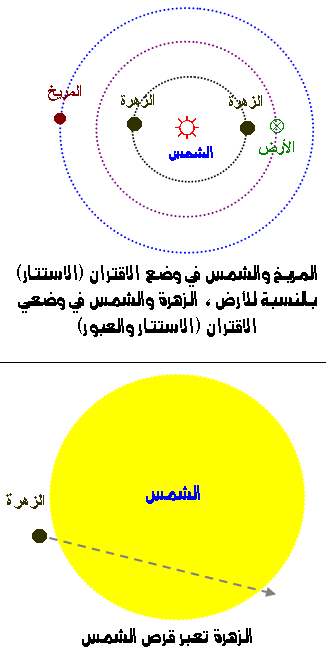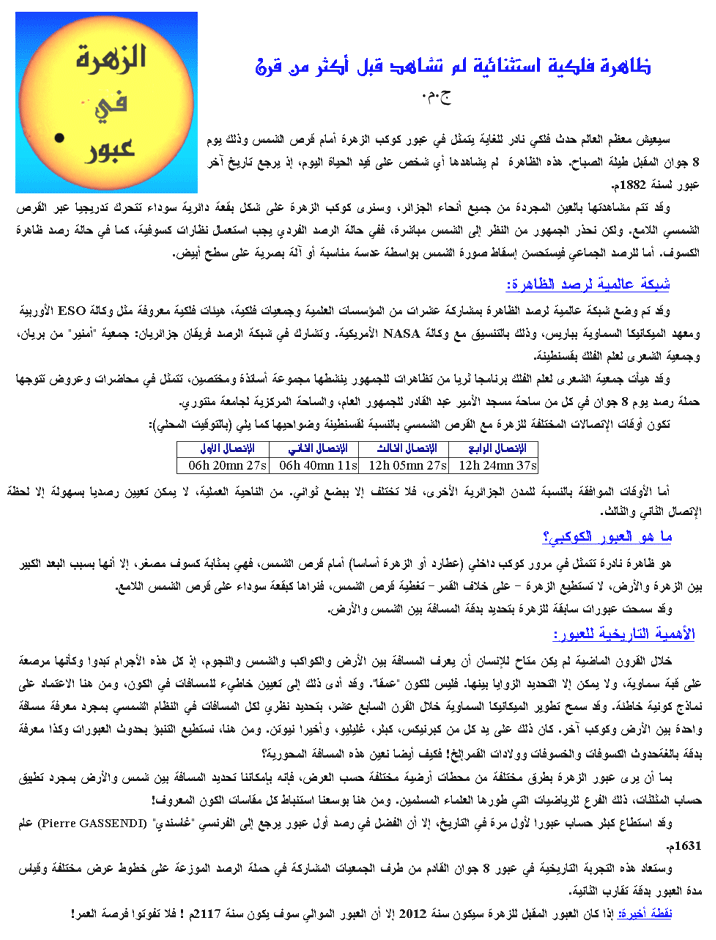|
عفاف بن دالي
حسين
جمعية الشعرى
لعلم الفلك، ماي 2004
·
ماذا
يحدث في 8 جوان 2004
؟
في 8 جوان
2004 ظاهرة فلكية نادرة جدا: "عبور كوكب الزهرة أمام قرص الشمس
", تعتبر ظاهرة عبور الزهرة نادرة جدا إذ انه لا يوجد شخص واحد من البشرية جمعاء مازال على قيد الحياة وقد
عايش هذا الحدث من قبل, حيث أن آخر "عبور للزهرة" حدث عام 1882
والذي كان يرى جزئيا في أوروبا (في جزء من أوروبا ). واحد من البشرية جمعاء مازال على قيد الحياة وقد
عايش هذا الحدث من قبل, حيث أن آخر "عبور للزهرة" حدث عام 1882
والذي كان يرى جزئيا في أوروبا (في جزء من أوروبا ).
إن مثل هذه
الظاهرة الفلكية, نادرة جدا, وتحرك في كل الفضوليين و هواة الرصد
الفلكي, روح المعرفة والاكتشاف والتي تساهم في الصعود بنا في معرفتنا
للكون الواسع الجميل.
·
ما هو عبور
الزهرة ؟
انه ببساطة
شديدة, ظاهرة فلكية: يمر من خلالها القرص العاتم لكوكب الزهرة من أمام
قرص الشمس, ويمكن أن نصف هذه الظاهرة على أنها: كسوف جزئي جدا للشمس,
باعتبار أن كوكب الزهرة لن يغطي إلا منطقة صغيرة من قرص الشمس لكنها
سهلة الرصد ( بالوسائل الوقائية اللازمة).
·
لماذا يعتبر "عبور كوكب الزهرة
" نادرا ؟
إن كوكب
الزهرة يدور حول الشمس في مدة 225 يوما بين الأرض و الشمس. إذن لا بد
أن نشاهد عبور الزهرة في كل دورة أي في كل " اقتران بين الزهرة و
الشمس" أي كل 584 يوم. هذا الأمر يكون صحيحا إذا كانت "الزهرة" و
"الأرض" تدوران حول الشمس في مستوى واحد.
إن مستوى
دوران كوكب الزهرة مائل تقريبا بـ 3 درجات عن مستوى دوران الأرض, الأمر
الذي يجعل الزهرة تمر خلال معظم دورانها تارة فوق قرص الشمس, و تارة
تحته, ولهذا، فلا نشاهد العبور بطريقة منتظمة عند كل
اقتران.
·
لماذا يعتبر
"عبور الزهرة" حدثا مهما؟
إن مثل هذه
القياسات ليست سهلة, حيث أنه غير ممكن أن نصل إلى كل الأجرام السماوية
لنقيس المسافة التي تبعد بها عن الأرض ؟
إن كل النجوم
والكواكب التي نشاهدها في "القبة السماوية" تبدوا وكأنها جميعا على بعد
واحد عنا, غير انه توجد طرق معقدة وعمليات رصد متخصصة لتسمح لنا بقياس
هذه المسافات الفلكية.
إن عملية رصد
عبور الزهرة, كانت العملية الأشهر في قياس المسافة التي تبعد الأرض عن
الشمس والتي تعتبر مفتاح ووحدة قياس المسافات الفلكية.
نلاحظ أنه
يوجد احتمال واحد ليحدث العبور:
لابد أن
تلتقي الشمس, الأرض, الزهرة, على خط واحد: هو تقاطع المستويين المدارين
للأرض والزهرة (ligne
des nœuds)
.
إن الأرض
تقطع هذا الخط في جوان وديسمبر, إلا أن الزهرة لا تلتقي مع الأرض في
مستوى واحد إلا نادرا, مرتين في قرن
وهذا ما يوضحه الجدول التالي:
|
7
ديسمبر 1631 |
|
4
ديسمبر 1639 |
|
6 جوان
1761 |
|
3 جوان
1769 |
|
9
ديسمبر 1874 |
|
6
ديسمبر 1882 |
|
8 جوان
2004 |
|
6 جوان
2012 |

![]()
Qu'est ce qu'un Transit de Vénus ?
J.M.
Le Transit de
Vénus
Rappelons que le transit
de Vénus consiste en son passage devant le disque solaire. La
Planète sera vue comme une petite tache circulaire noire qui
défilera à partir de 6h20 du matin jusqu'à 12h25 et sera visible de
toute l'Algérie, ainsi d'ailleurs que tous les pays dont la journée
tombera durant cette période. Cet événement revêt une importance
historique et culturelle de premier ordre puisque c'est grâce à un
transit similaire de Venus que fut déterminé pour la première fois
de manière précise la distance Terre - Soleil et de là, la
détermination des dimensions du Système Solaire et de
l'Univers!
Le Réseau mondial de
coordination VT-2004
Un réseau mondial de coordination a été mis en place (VT-2004)
pour l'observation minutieuse de ce phénomène avec pour l'Europe,
l'Agence Européenne d'Astronomie (ESO), l'Institut de Mécanique
Céleste de Paris ainsi que des dizaines d'organismes professionnels
et amateurs. Notons que notre Association ainsi que le Club Amnir
de Berriane sont les deux Associations Algériennes membres officiels
de VT-2004. La détermination à la seconde près des instants de
début et de fin du transit va permettre une nouvelle détermination de
la distance Terre-Soleil. Bien que cette " manip " aie été
rendue obsolète par l'utilisation des techniques radar dans les
années soixante-dix pour une détermination rigoureuse des distances,
son intérêt tant pédagogique que culturel demeure.
Le Transit du 8Mai 2004
Les
différentes phases du transit s'établissent comme suit pour
Constantine et sa région (heure locale):
|
Premier
contact |
Deuxième
contact |
Troisième contact |
Quatrième contact |
|
06 h20m 27s |
06h 40mn 11s |
12h 05mn 27s |
12h 24mn
37s |
Les horaires correspondants pour les autres villes
d'Algérie ne diffèrent que de quelques secondes. Du point de vue
pratique, seuls les deuxième et troisième contacts peuvent être
déterminés sans ambiguïté par l'observation.
Sauf pour une
répétition du phénomène en 2012 qui ne sera pas visible de notre
pays, le transit suivant se déroulera en 2117. Ne laisser pas passer
l'occasion de ce transit!
Was J.Horrocks really  the first one to see the Venus
transit? the first one to see the Venus
transit?
Unfortunately the site's URL is gone. In it, Pouria Nazemi, the author of the article, asserts in Nojum, the famous Iranian Astronomy Magazine, that the Persian Islamic scientist Avicenna witnessed the 1032 transit of Venus. Avicenna claims in his book Shifa, "I say that I have seen Venus as a spot on the Sun’s face."
| 
